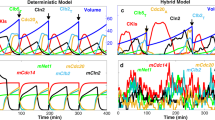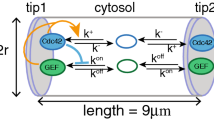Abstract
A structured segregated model of budding yeast (Saccharomyces cerevisiae) populations is analysed in order to verify its ability to predict the spontaneous oscillations arising in continuous cultures. To obtain tractable and useful information about the relationships among the metabolic modifications during the cell cycle, the control over division and the occurrence of oscillations, very simple assumptions are considered and added to the model. The cell metabolism has been taken into account by assuming a diversification in the yield coefficient during the cell cycle. Moreover, in the oscillatory range, the cell mass is assumed to be constant at budding and to depend on the limiting substrate concentration at division. For a suitable range of parameter values, sustained oscillations are obtained, which can be compared to the experimental ones.
Similar content being viewed by others
Abbreviations
- D :
-
dilution rate
- K h :
-
critical substrate for h
- K s :
-
saturation constant
- h :
-
ratio between size at division and size at budding
- h max :
-
maximum h value
- h min :
-
minimum h value
- s :
-
substrate concentration
- s in :
-
substrate concentration in the input flow
- x :
-
budded biomass concentration
- y :
-
unbudded biomass concentration
- Y x :
-
yield coefficient for budded biomass
- Y y :
-
yield coefficient for unbudded biomass
- μ :
-
specific growth rate
- μ max :
-
maximum specific growth rate
References
Agrawal, P.; Lee, C.; Lim, H. C.; Ramkrishna, D.: Theoretical investigations of dynamic behavior of isothermal continuous stirred tank biological reactors. Chem. Eng. Sci. 37 (1982) 453–462
Borzani, W.; Gregori, R. E.; Vairo, M. L. R.: Some observations on oscillatory changes in the growth rate of Saccharomyces cerevisiae in aerobic continuous undisturbed culture. Biotechnol. Bioeng. 19 (1977) 1363–1374
Carter, B. L. A.; Jagadish, M. N.: The relationship between cell size and cell division in the yeast Saccharomyces cerevisiae. Exp. Cell Research 112 (1978) 14–24
Cazzador, L.; Mariani, L.: A simulation program based on a structured population model for biotechnological yeast processes. Appl. Microbiol. Biotechnol. 29 (1988) 198–202
Crooke, P. S.; Wei, C. W.; Tanner, R. D.: The effect of the specific growth rate and yield expressions on the existence of oscillatory behavior of a continuous fermentation model. Chem. Eng. Commun. 6 (1980) 333–347
Hartwell, L. H.; Unger, M. W.: Unequal division in Saccharomyces cerevisiae and its implications for the control of cell division. J. Cell Biol. 75 (1977) 422–435
Heinzle, E.; Dunn, I. J.; Furukawa, K.; Tanner, R. D.: Modelling of sustained oscillations observed in continuous culture of Saccharomyces cervisiae. In: 1st Workshop on Modelling and Control of Biotechnical Processes, IFAC Helsinki (1982) 57–65
Johnston, G. C.; Ehrhardt, C. W.; Lorincz, A.; Carter, B. L. A.: Regulation of cell size in the yeast Saccharomyces cerevisiae. J. Bacteriol. 137(1979) 1–5
Kuenzi, M. T.; Fiechter, A.: Changes in carbohydrate composition and trehalase-activity during the budding cycle of Saccharomyces cerevisiae. Arch. Mikrobiol. 64 (1969) 396–407
MacDonald, N.: Time lags in biological models. Berlin Heidelberg New York: Springer Verlag 1978
Mariani, L.; Martegani, E.; Alberghina, L.: Yeast population models for monitoring and control of biotechnical processes. IEE Proc. 133 PtD (1986) 210–216
Martegani, E.; Mariani, L.; Alberghina, L.: Yeast biotechnological processes monitored by analysis of segregated data with structured models. In: Johnson, A. (Ed.): Modeling and Control of Biotechnical Processes, 237–243. Pergamon Press 1985
Martegani, E.; Porro, D.; Ranzi, B. M.; Alberghina, L.: Involvement of the cell size control mechanism in the induction and maintenance of oscillations in continuous cultures of budding yeast. In press
Parulekar, S. J; Semoens, G. B.; Rolf, M. J; Lievense, J. C.; Lim, H. C.: Induction and elimination of oscillations in continuous cultures of Saccharomyces cerevisiae. Biotechnol. Bioeng. 28 (1986) 700–710
Porro, D.; Martegani, E.; Ranzi, B. M.; Alberghina, L.: Oscillations in continuous cultures of budding yeast: a segregated parameter analysis. Biotechnol. Bioeng. 32 (1988) 411–417
Strassle, C.; Sonnleitner, B.; Fiechter, A.: A predictive model for the spontaneous synchronization of Saccharomyces cerevisiae grown in continuous culture. I. Concept. J. Biotechnol. 7 (1988) 299–318
Thingstad, T. F.; Langeland, T. I.: Dynamics of chemostat culture: the effect of a delay in cell response. J. Theor. Biol. 48 (1974) 149–159
Tyson, C. B.; Lord, P. G.; Wheals, A. E.: Dependency of size of Saccharomyces cerevisiae cells on growth rate. J. Bacteriol. 138 (1979) 92–98
Von Meyenburg, H. K.: Energetics of the budding cycle of Saccharomyces cerevisiae during glucose limited aerobic growth. Arch. Mikrobiol. 66 (1969) 289–303
Author information
Authors and Affiliations
Rights and permissions
About this article
Cite this article
Cazzador, L., Mariani, L., Martegani, E. et al. Structured segregated models and analysis of self-oscillating yeast continuous cultures. Bioprocess Engineering 5, 175–180 (1990). https://doi.org/10.1007/BF00369582
Received:
Issue Date:
DOI: https://doi.org/10.1007/BF00369582




